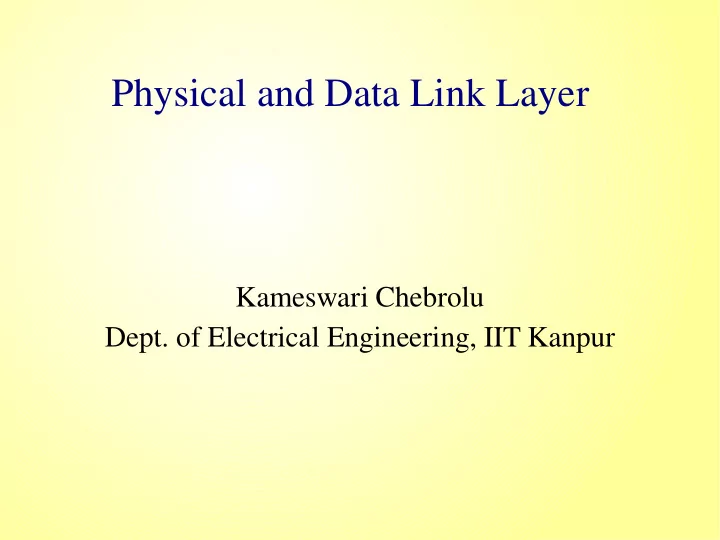

Physical and Data Link Layer Kameswari Chebrolu Dept. of Electrical Engineering, IIT Kanpur
Problem Statement ● Make two computers talk to each other Pictures courtesy Peterson & Davie
Encoding ● Physical media transmit Analog signals ● Modulate/demodulate: – Encode/decode binary data into signals – E.g. Non-return to Zero (NRZ) ● 0 as low signal and 1 as high signal 0 0 1 0 1 1 1 1 0 1 0 0 0 0 1 0 Bits NRZ Picture courtesy Peterson & Davie
Problems with NRZ ● Consecutive 1s and 0s – Changes the average making it difficult to detect signals ( baseline wander ) – Clock Recovery ● Sender's and receiver clocks have to be precisely synchronized ● Receiver derives the clock from the received signal vis signal transition ● Lesser number of transitions leads to clock drift
Alternative Encodings ● Non-return to Zero Inverted (NRZI) – To encode a 1, make a transition – To encode a 0, stay at the current signal – Solves problem of consecutive 1's but not 0's ● Manchester Encoding – Transmits XOR of the NRZ encoded data and the clock ● 0 is encoded as low-to-high transition, 1 as high-to-low transition – Only 50% efficient
Example 0 0 1 0 1 1 1 1 0 1 0 0 0 0 1 0 Bits NRZ Clock Manchester NRZI Picture courtesy Peterson & Davie
4B/5B Encoding ● Every 4 bit of actual data is encoded into a 5 bit code ● The 5 bit code words have – No more than one leading 0 – No more than two trailing 0s – Solves consecutive zeros problem ● The 5 bit codes are sent using NRZI ● Achieves 80% efficiency
4B/5B Encoding Picture courtesy Google
Framing ● Blocks of data exchanged between nodes ● We know how to transmit sequence of bits over a link ● Challenge: What sets of bits constitute a frame – Where is the beginning and the end of frame? ● Framing Protocols – Examples: PPP, HDLC, DDCMP
Byte Oriented protocols ● Frame is a collection of bytes and not bit stream ● Sentinel approach – Use a special byte to mark beginning and end of frame ● Example: BISYNC (binary synchronous communication) protocol (developed by IBM) – Character Stuffing: Escape ETX with DLE (data-link-escape) – Escape DLE with another DLE 8 8 8 8 8 16 Header Body CRC Picture courtesy Peterson & Davie
Cont... ● Example: Point to Point protocol (PPP) – Flag is 01111110 8 8 8 16 16 8 Flag Address Control Protocol Payload Checksum Flag ● Byte Counting approach – Include number of bytes contained in the frame in the header – Example: DDCMP 8 8 8 14 42 16 Count Header Body CRC Picture courtesy Peterson & Davie
Bit-Oriented Protocols ● Not concerned with byte boundaries ● Example: High-Level Data Link Control (HDLC) 8 16 16 8 Beginning Ending Header Body CRC sequence sequence – Sequence is 01111110 – Special pattern may appear in payload – Solution: Bit Stuffing ● Sender inserts a 0 after 5 consecutive 1's ● Receiver removes the 0 that follows 5 1's Picture courtesy Peterson & Davie
Error Detection ● Links suffer from errors ● Basic Idea: Add redundant information to a frame – At Sender ● Add k bits of redundant data to a n bit message ● k << n; k = 32; n = 12,000 for Ethernet ● k derived from original message through some algorithm – At Receiver ● Reapply same algorithm as sender ● Redundant bits must match; take corrective action otherwise
Two Dimensional Parity Parity bits 0101001 1 ● Example: 1101001 0 1011110 1 Data 0001110 1 0110100 1 1011111 0 Parity 1111011 0 byte ● 14 bits of redundancy for a 42 bit message ● Catches all 1,2,3 bit errors and most 4 bit errors ● Used by BISYNC protocol for ASCII characters Picture courtesy Peterson & Davie
Internet Checksum ● View data in a frame to be transmitted as a sequence of 16-bit integers. ● Add the integers using 16 bit one's complement arithmetic. ● Take the one's complement of the result – this result is the checksum ● Not very strong in detecting errors
Cyclic Redundancy Check ( CRC) ● Uses powerful math based on finite fields ● Represent a n+1 bit message with a polynomial of degree n, Message polynomial M(x) – 11000101 = x7 + x6 +x2 + 1 ● Sender and receiver agree on a divisor polynomial C(x) – C(x) = x3+x2+1 (degree k = 3) – Choice of C(x) significantly effects error detection ● Ethernet uses CRC of 32 bits, HDLC, DDCMP use 16 bits ● x32+x26+x23+x22+x16+x12+x11+x10+x8+x7+x5+x4+x2+x+1
Cont..... ● Sender sends n+1+k bits => Transmitted message P(x) ● We contrive to make P(x) exactly divisibly by C(x) ● Received message R(x) – No errors: R(x) = P(x), exactly divisible by C(x) – Errors: R(x) ~= P(x); likely not divisible by C(x) ● Polynomial Algebra Rules:
Generate P(x) ● Multiply M(x) by x^k to get T(x) – Add k zeros at the end of the message ● Divide T(x) by C(x) to get remainder ● Subtract remainder from T(x) to get P(x) ● P(x) is now exactly divisible by C(x) ● Example:
Error Correction ● More complex math ● Needs more redundancy ● Tradeoff between error detection and correction – Error detection needs another copy to be transmitted if error is detected ● Wastes bandwidth and introduces latency – Error detection requires more bits to be sent when errors occur – Error Correction requires more bits to be sent all the time
Recommend
More recommend